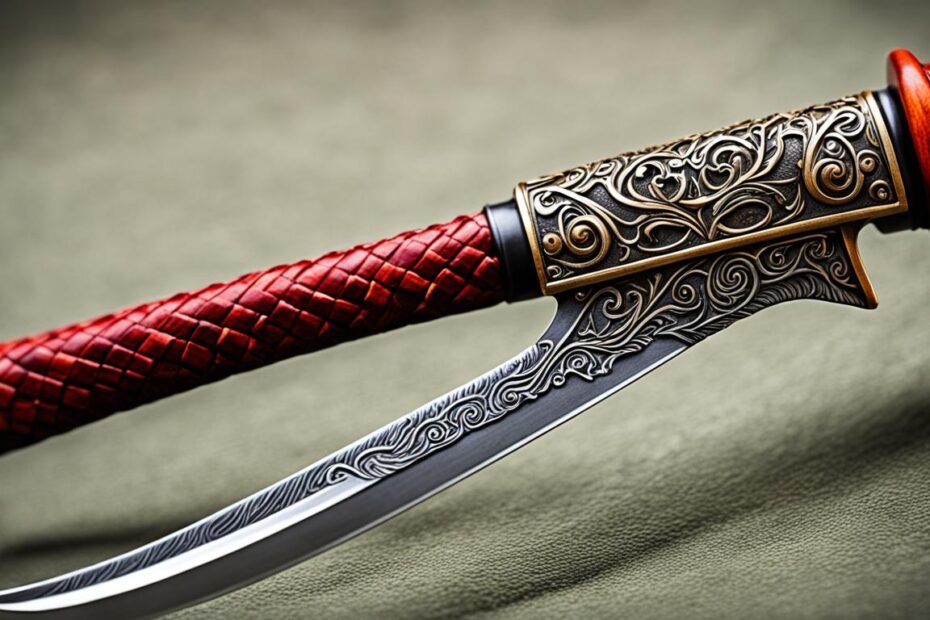Welcome to our in-depth exploration of the Golok, a traditional Filipino sword known for its versatility, rich history, and cultural significance. In this article, we will delve into the various uses of this unique blade and uncover its fascinating origins.
The Golok is not just an ordinary sword; it holds a special place in Filipino culture and tradition. With its distinctive design and exceptional functionality, the Sword Golok has been used for centuries in a multitude of practical applications.
When it comes to functionality, the Golok shines in both agricultural and combat settings. Farmers have relied on its sturdy construction and sharp edge for clearing vegetation, cutting through dense jungle, and harvesting crops. At the same time, the Golok has proven to be a formidable self-defense weapon, thanks to its outstanding cutting, chopping, and slicing abilities.
However, the Golok is more than just a tool or weapon. Its history is deeply intertwined with Filipino heritage, representing an essential part of the country’s cultural identity. As we delve into the history and cultural significance of the Sword Golok, you will uncover the stories, traditions, and symbolic value associated with this remarkable blade.
Join us as we embark on a journey to discover the Sword Golok’s traditional uses, delve into its intriguing history, and explore its deep-rooted cultural significance within the Filipino community.
The Versatility of the Sword Golok
When it comes to the Sword Golok, versatility is at the heart of its design. This traditional Filipino blade showcases a range of practical applications, making it not only a farming tool but also a formidable self-defense weapon.
As a farming tool, the Sword Golok proves its worth in various agricultural tasks. Its sharp blade effortlessly cuts through thick vegetation, clearing paths and making way for cultivation. Moreover, the curved design enables efficient chopping and splitting of wood, essential for constructing structures or fueling fires. Its versatility as a farming tool has made it a staple among Filipino farmers for generations.
But the Sword Golok is not limited to the fields. Its adaptability extends to self-defense as well. With its balanced weight distribution and sharp edge, it can be wielded effectively for protection. In close combat situations, the Golok’s size and maneuverability allow for swift strikes and precise slicing, capable of incapacitating or disarming adversaries.
Whether you need to clear your land or protect yourself, the Sword Golok rises to the occasion. Its practical applications in farming and self-defense make it a trustworthy and multipurpose tool. By combining functionality with a rich cultural heritage, the Sword Golok truly embodies the essence of Filipino craftsmanship.
History and Cultural Significance of the Sword Golok
The Sword Golok holds a profound place in the history of the Philippines, reflecting the country’s rich heritage and cultural identity. With a lineage dating back centuries, this traditional blade carries tales of Filipino warriors and skilled craftsmen.
Originating in the southern regions of the Philippines, the Sword Golok has deep ties to Filipino heritage. It was an integral part of indigenous tribes and played a significant role in rituals, ceremonies, and even warfare. Passed down through generations, it represents the craftsmanship and resilience of the Filipino people.
Beyond its practical uses, the Sword Golok holds immense cultural importance. It symbolizes bravery, strength, and honor, embodying values deeply rooted in Filipino culture. The blade is often associated with stories of heroism and legendary figures, further adding to its mystique and allure.
Today, the Sword Golok continues to be treasured as a cultural icon. It serves as a reminder of the Philippines’ formidable past, a testament to the resilience of its people. With its intricate designs and historical significance, the Sword Golok stands as a bridge between ancient traditions and the modern world, ensuring the preservation of Filipino heritage for future generations.
